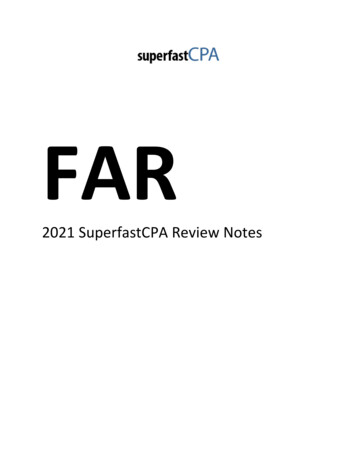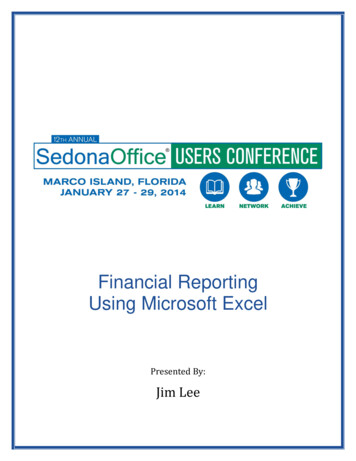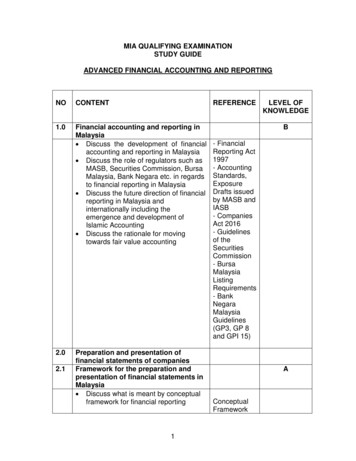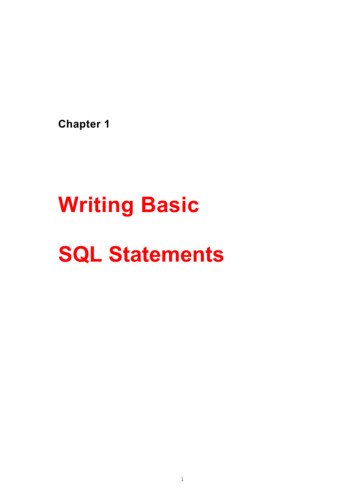
Transcription
Management AccountingFinancial Statements for Manufacturing BusinessesImportance of Financial StatementsAccounting plays a critical role in decision-making. Accounting provides thefinancial framework for analyzing the results of an executed set of decisions andmakes possible the continuous success of a business or improvement in operations.Secondly, accounting provides much of the necessary information needed in makinggood decisions. Thirdly, the management accountant provides a knowledge of basicdecision-making tools that helps find the best alternative in decision-making.It is the accountant’s knowledge about preparing financial statements and his orher abilities to analyze and interpret financial statements that makes the controllershipfunction in a business so valuable to management. However, it is also important formanagement to have a fundamental knowledge of financial statements, particularlyregarding the analysis and evaluation of financial statements to make decisions.A primary objective of a business is to increase the assets from operations. Byoperations is meant all the revenue and expense transactions of a business for adefined period of time. Since the excess of revenue over expenses (net income)increases the equity of a business, it is often said that the primary objective is toincrease stockholders’ wealth, assuming the business is a corporation. The successof a business in financial terms, then, depends on how well management managesrevenues and expenses. In other terms, the decisions that management makesconcerning the operations of the business are of paramount importance. Managementhas the responsibility to make the kinds of decisions that generates net income.Revenues are the inflow of assets caused by the operations of the business. Theterm revenue necessarily implies increases in assets. If a transaction does not causean increase in an asset, then that transaction is not a revenue transaction. Followingis a list of several types of items that fall under the category of revenue:RevenueSalesInterest IncomeRental incomeAsset InflowCash or Accounts receivableCash or interest receivableCash or rent receivable 31
32 CHAPTER THREE Financial Statements for Manufacturing BusinessExpenses are the outflow of assets from the operations of the business. Expensesare caused by activities necessary to generate revenue. When revenues exceedsexpenses as is the goal, the difference is called net income. If a transaction does notcause a decrease in an asset, then that transactions is not an expense. Followingis a list of several expenses and the asset decrease associated with that particularexpense.ExpenseCost of goods soldSalariesSupplies expenseDepreciation, buildingAsset outflowPrepaid insuranceExpired life of the service valueSuppliesExpired cost of a buildingTechnically, the asset outflow associated with salaries is not cash. Payments aremade to workers and other employees because they create something of value. Inmore technical terms an expense is the expired value of an asset. A janitor is paidto clean floors. The thing of value acquired is a clean floor and as long as the floorremains clean, it is something of value. However, when the clean floor becomes dirtyagain, then the value of the clean floor asset has expired. Because many assets havea very short life, the accountant often simply records the expense even though thevalue of the assets at the time of recording has not yet expired.Often the acquisition of an asset is not paid for immediately and the amount thenowed is called a liability. Liabilities are debts or obligations to pay at some future dateand are a common form of financing in a business. There are three primary sourcesof assets in a business: (1) revenues (2) liabilities (3) capital. The five key wordsfrom an accounting viewpoint and also from a management viewpoint are assets,liabilities, capital, revenue, and expenses.In one sense, the purpose of management is to make asset, liabilities, capital,revenue, and expense decisions. Since the income statement shows revenues,expenses and net income and the balance sheet shows assets, liabilities, and capital,we can say that the purpose of management is to manage assets, liabilities, capital,revenue, and expenses. Stated simply, the purpose of management is to managefinancial statements.Because of the importance of sound operations and financial condition, it is critically important for both management and accountants to have a sold understandingof financial statements. While accountants prepare financial statements, it is management that creates financial statements through the decisions it makes. Because ofthe importance of financial statements, the rest of this chapter is concerned withpresenting the fundamentals of financial statements for a manufacturing business.The four financial statements of critical value in this text are as follows:1.2.3.4.Balance sheetIncome statementCost of goods manufactured statementStatement of cash flow
Management AccountingFinancial statements are based on well defined accounting concepts andstandards, some of which are fairly technical and require some concentrated study tolearn and use. The following is a list of accounting terminology and concepts importantin understanding financial statements for a manufacturing business.Accounting TerminologyAmortizationAccounts receivableAccounts payableBondsBad debtsCreditCapitalCashCommon stockContribution marginCostCurrent assetsCost of goods soldCost of goods manufacturedDepreciationDirect costDividendsFinished goodsFixed assetsFactory laborFixed costGain/loss on saleGross profitIndirect costInventoryIncome taxesInvestmentManufacturing overheadMaterial usedNet incomeNet operating incomeNet income after taxesPerpetual inventoryPeriodic inventoryRetained earningsPremium/discount on stockPremium/discount on bondsStockholders’ equityTax expenseTreasury stockTrade-in valueVariable costHopefully, you have learned these terms in a previous accounting course andonly some review of these terms is needed.In addition to terminology, there are some accounting concepts and conventionsof a broader nature that involve theory and even, in some cases, considerabledifferences of opinion. Some of the important concepts involved in this book areshown as follows.Accounting ConceptsAbsorption costingAccrual basis accountingAccounting controlCash basis accountingCostControlDeferred chargesDirect costingEarned/unearned revenueInventory costing methodsMatchingPlanningStandards/principles of accountingFull costing reportingContribution basis reportingAccounting Financial Statement RelationshipsIn addition to important financial statement terminology, there are a number ofmanufacturing financial statement relationships critical to understanding and usingfinancial statements. These relationships may be summarized as simple mathematicalequations. The most important of these relationships are the following: 33
34 CHAPTER THREE Financial Statements for Manufacturing BusinessCost of Goods Manufactured StatementMaterial used materials (beginning) material purchases - materials inventory(ending)Cost of goods manufactured materials used factory labor manufacturingoverhead work in process (beginning) - work in process (ending)Income statementCost of goods sold finished goods (beginning) cost of goods manufactured- finished goods (ending)Finished goods (beginning) plus cost of goods manufactured is often calledgoods available for sale.Net income sales - cost of goods sold - operating expensesThe difference between sales and cost of goods sold is often reported as grossprofit.Balance SheetAssets liabilities stockholders’ equityAssets current assets fixed assets other assetsLiabilities current liabilities long-term liabilitiesStockholders’ equity common stock premium/discount on common stock retained earningsStatement of Cash FlowChange in cash sources and uses from operations sources and uses fromfinancing activities sources and uses from investing activities.While the above equations may seem a bit complex and imposing, theserelationships still, nevertheless, form the foundation of financial statements fora manufacturing company. Since it is critical that managerial decision-makersunderstand and use financial statement information, it is essential that the seriousstudent of management understand these basic financial statement relationships.A complete set of financial statements for the last period of operations may befound in chapter 9 of The Management/Accounting Simulation. However, often asummarized version is easier understand and use for some purposes. Therefore, asummarized version of the financial statements for the V. K. Gadget Company is nowpresented in Figure 3.1.Analyzing Financial StatementsUnderstanding financial statements is only the first step in using them. The secondstep is to analyze them in order to discover any existing or potential problem areas ofprofit performance or financial conditions that needs corrective action. Several toolsexist that may be used including the following:1. Comparative statements2. Financial statement ratios
Management AccountingFigure 3.1 Financial StatementsV. K. Gadget CompanyCost of Goods Manufactured StatementFor the 4th Quarter, Year 1Materials Inventory (B)Material Purchases 1,940,1604,892,1606,832,320Materials Inventory (E)2,065,114Material used4,767,206Factory labor2,787,840Manufacturing Overhead (V)323,424 7,878,470Units manufacturedCost per unit57,027 138.16V. K. Gadget CompanyBalance SheetDec. 31, year 1AssetsCurrent AssetsFixed assetsOther assetsTotal AssetsLiabilitiesCurrent liabilitiesLong-termTotal liabilitiesStockholders’ EquityCommon stockPremium on common stockRetained earningTotal stockholders’ equityTotal liabilities and equityV. K. Gadget CompanyIncome StatementFor the 4th quarter, Year 1SalesCost of goods soldGross profitExpensesSellingGeneral and Admin.Fixed mfg. overhead �––––Total t operating income(2,302,354)Other income & expenses112,500)Income taxes(965,941)––––––––––Net loss( ��––––––V. K. Gadget CompanyStatement of Cash FlowFor the quarter Ended, Dec. 31, year 1 – ��––––––––Cash flow from Operating �– 5,630,523–––––––––––Cash flow from Investing ��––-0Cash flow from financing ��––-0–––––––––––Net decrease in cash -0––––––––––– –––– 4,500,754––––––––––– ��––––––––SourcesUses –Excess of uses over sources-0- 35
36 CHAPTER THREE Financial Statements for Manufacturing BusinessThe use of ratios is a commonly used method to determine conditions that mightbe a current or future problem. The current ratio can be computed to determine ifcurrent assets are sufficient to make payments of current liabilities. The debt/equityratio is a good indicator of whether the company is too heavily burdened with debt.The profit margin percentage is a good measure of the adequacy of net income tosales. The computation of the return on investment ratio is an excellent benchmarkfor determining whether net income is satisfactory or unsatisfactory. Numerous otherratios may be computed and most elementary accounting textbooks do an excellentjob of discussing the more important ratios. A detailed discussion of ratios is presentedin chapter 17.Financial Statements: A Model of Decision-makingAlso, financial statements may be used as a guide to identifying what financialstatements elements are directly affected by a specific decision. This approach is notcommonly used, but because it is helpful in understanding how decisions affect thevarious items of financial statements, it is discussed here now in some detail. Forexample, every item on the balance sheet such as accounts receivable or inventoryis the result of the execution of one or more identifiable decision. It is management’sprimary responsibility to manage each element of a given financial statement. Financialstatements, in one sense, are a check list of what management is to manage. Thisapproach states rather explicitly, as previously discussed, that a primary purpose ofmanagement is to manage assets, liabilities, capital, revenue, and expenses.To clarify the above statements, the following financial statements of the V. K.Gadget Company are presented in terms of decisions and required information.Figure 3.2 Cost of Goods Manufactured StatementCost ier A, B, C, or DOrder size, material XNumber of orders, material XOrder size, material YNumber of orders, material YList pricesQuantity discountsCarrying costCost of placing an orderDirect labor (variable)Number of factory workersWage rateBudgeted productionUnits of equipmentWage rate functionProduction budgetManufacturing overheadType of finishing departmentequipmentOrder size of materialCapacity requiredFactory labor compensationCarrying cost of inventoryOverhead rateVariable cost ratesSalaries, supervisors
Management AccountingThese financial statement models presented in terms of decisions and requiredinformation rather than actual values clearly indicate an important point. It ismanagement rather than accountants that actually creates financial statements. Thefinancial well being of the company’s operations is clearly the full responsibility ofmanagement.Accounting Policies and ProceduresWhile the operating and financial success of a company falls squarely on theshoulders of management, there is still considerable latitude on the part of accountantsin preparing financial statements. Any accounting system involves rules, standards,and procedures that can vary from company to company. The overall guiding principleFigure 3.3 Income StatementItemDecisionsInformation RequiredSalesPriceCredit termsAdvertisingCommission rateNo. of sales peopleSales people salaryDemand scheduleSales-calls functionAdvertising ratesCommission rate functionCalls per quarterCost of goods soldSame as cost of goodsmanufactured (see above)Sales decisions (see above)Same as cost of goodsmanufactured and salesdecisionsAdvertising budgetAdvertising costNumber of sales peopleCommission rateSales people salariesCredit termsDemand curveSales people compensationfunctionCredit terms functionCredit department expensesOperating costsExpensesAdvertisingSales peoplecompensationCredit expenseDepreciationUnits of equipment andfinishingDepartment equipmentreplacementDepreciation ratesBad debtsCredit termsCredit terms functionInterest expenseBank loansIssue of bondsLine of creditInterest rateCost of capitalDiscount rate 37
38 CHAPTER THREE Financial Statements for Manufacturing Businessis that once rules, standards, and procedures have been adopted, they should beconsistently applied. In the V. K. Gadget Company, the following procedures andmethods have been adopted.Figure 3.4 Accounting Policies and ProceduresItemProcedureMaterial costing methodAverage costingFinished goods costing methodAverage costingBad debt methodPercentages of sales methodDepreciation of equipmentStraight-lineIncome formatSegmental income statementManufacturing overhead costingmethodDirect costing (variable costing)Treatment of common expensesAllocation by sales ordersIncome taxesNet income is shown net of taxesBond discountScientific amortization methodManagement Accounting SystemsIn addition to understanding and utilizing financial statements and financialaccounting tools, it is important that both accountants and management have a goodunderstanding of management accounting concepts and tools. One of the mosteffective tools is comprehensive business budgeting. The objective of comprehensivebudgeting is to prepare a set of financial statements in advance. The end result of thebudgeting process is a planned set of financial statements. A comprehensive budgetingsystem for the V. K. Gadget company, the simulated company in The Management/Accounting Simulation, has been developed and is ready for use. Whether or notthis system should be used is a decision that you would make, assuming you are aparticipant in the simulation, and serving in the role of new management. In additionto the comprehensive budget, other computerized management accounting tools areavailable for use. These tools include:1. Business budgeting2. Cost behavior3. Cost-volume-profit analysis4. Capital budgeting analysis5. Credit analysis6. Demand sensitivity analysis7. Direct costing analysis (variable costing)
Management Accounting8.9.10.11.13.14.15.16.Incremental analysisInventory management analysisKeep or replace analysisPerformance evaluationReturn on investmentSales people compensation analysisSegmental contribution reportingWage rate analysisIf your instructor has adopted this simulation in connection with this text book,then hopefully your participation in The Management/Accounting Simulationwill give you an experience that will solidly persuade you that in any business theaccounting department is a vital function in the process of decisions being madeand executed. With a proper attitude on the part of accounting towards managementand management towards accounting, the likelihood of better decisions and a moresuccessful business is greatly increased.Comparison of Merchandising and Manufacturing BusinessesIn order to understand financial statements for a manufacturing business, as astudent you first need a good understanding of financial statements for a merchandisingbusiness. In general, merchandising and manufacturing statements are the same, Infact, in terms of basic components they are identical.Figure 3.5 Retail BusinessManufacturing BusinessIncome StatementIncome StatementThe five basic elements of the incomestatement for a retail business are:The five basic elements of the incomestatement for a manufacturing business are:1. Sales2. Cost of goods sold3. Gross profit4. Expenses5. Net income 00––––––––– �–––1. Sales2. Cost of goods sold3. Gross profit4. Expenses5. Net income 00––––––––– �–––The major difference is in the need to know how to compute cost of goodsmanufactured as seen in the following comparison. 39
40 CHAPTER THREE Financial Statements for Manufacturing BusinessFigure 3.6 MerchandisingManufacturingCost of goods sold1. Merchandise inventory (B)2. Merchandise purchases–Available for sale3. Merchandise inventory (E)––– 15,00075,000– ––––––90,00030,000– –––––– 60,000–– ––––––––––––Cost of goods sold1. Finished goods inventory (B)2. Cost of goods manufactured 15,00075,000––––––––Available for sale90,0003. Finished goods inventory (E)30,000– ––––––– 60,000–– ––––––––––––––The Cost of Goods Manufactured StatementThe major difference here is obviously in the need to know how to compute costof goods manufactured. A second difference is that in a manufacturing businessinventory that is sold is called finished goods rather than being called merchandiseinventory and cost of goods manufactured has replaced merchandise purchases.Rather than purchasing goods from another company, the company manufactureswhat it sells. The accounting for finished goods is far more complicated than theaccounting for merchandise purchased.Figure 3.7 Cost of goods manufacturedThe five basic elements of cost of goods manufactured are:1. Materials used2. Factory labor3. Manufacturing overheadManufacturing costs incurred this period4. Work in process inventory (B)Total manufacturing costs to be acct. for5. Work in process inventory (E) ,000– –––––––100,00025,000– ––––––– 75,000––––––––– –––––––The purpose of the cost of goods manufactured statement is to compute the costof goods completed or finished in a given time period. The cost of goods manufacturedis the cost of goods finished this period. Cost of goods manufactured consists of threebasic cost elements: (1) materials, (2) factory labor, and (3) manufacturing overhead.Materials used is a computation:
Management AccountingMaterials Used1. Materials inventory (B)2. Material purchases 5,00025,000Materials available3. Materials inventory (E)30,00010,000 20,000There are two types of inventory systems that may be used in a manufacturingbusiness: (1) periodic and (2) perpetual. If a periodic inventory system is used, then itis necessary to compute materials used. If perpetual inventory is used, the inventorysystem keeps an accurate perpetual record of materials used and, consequently, itis not necessary to compute materials used. A record in the cost accounting systemcalled Materials Used Summary is to record each use of material.Balance Sheets: Merchandising and Manufacturing ComparedThe balance sheet of a manufacturing business in terms of basic elements isidentical to the balance sheet of a merchandising business. The only differenceis in one area, the current asset section. Instead of one inventory account, themanufacturing business has three inventory accounts:Merchandising Business1. AssetsCurrent assetsCashAccounts receivableMerchandise inventoryFixed assets2. LiabilitiesCurrent liabilitiesLong-term liabilities3. Stockholders’ EquityPaid-in capitalRetained earnings 50,00030,00065,000 55,000–––––––– ��– 20,00030,00030,000120,000–––––––– ��–Manufacturing Business1. AssetsCurrent assetsCashAccounts receivableInventoryWork in processMaterialsFinished goodsFixed assets2. LiabilitiesCurrent liabilitiesLong-term liabilities3. Stockholders’ EquityPaid-in capitalRetained earnings �–––– ��––– �� ��––– 41
42 CHAPTER THREE Financial Statements for Manufacturing BusinessManufacturing Business Transactions and Journal EntriesThe manufacturing business has a number of unique transactions not found in amerchandising business. These transactions as a whole all fall into the manufacturingcosts category. Basically, there are three types of manufacturing transactions:1. Material2. Factory labor3. Manufacturing overheadThe most common of these three types of transactions are the following:1. Purchase of raw materials2. Freight on material purchased3. Material returns and allowances4. Incurrence of direct factory labor5. Incurrence of manufacturing overheadExamples of manufacturing overhead incurred include:1. Indirect factory labor and indirect material2. Factory utilities3. Repairs and maintenance on factory equipment4. Factory insurance5. Depreciation on factory equipmentExamples of how to record material, factory labor, and manufacturing overheadtransactions are now presented. These transactions are reflected in the adjusted trialbalance on the next page.Journal Entries for Basic Manufacturing TransactionsTransactionJournal EntryDebit110,000 units of material X were purchasedfor 12 per unit.Material purchasesAccounts payable120,0002Invoice on freight received for material X, 2,000.Freight-in - materialsAccounts payable2,0003Damaged material X returned, 5,000.Accounts payableMaterial returns5,0004Factory workers paid:Direct factory workers 200,000Indirect factory labor 50,000Factory labor - DirectMfg. overhead - Indirect laborPayroll payable200,00050,0005Other Manufacturing overhead for themonth was as follows:Factory utilities 5,000Factory repairs andmaintenance 3,000Factory insurance 4,000Factory supplies 1,000Manufacturing overheadAccounts payableFactory utilities 5,000Repairs and main. 3,000Factory insurance 4,000Factory supplies 1,00013,0006Depreciation on plant & equipment, 2,000Mfg. overhead - plant deprec.Allowance for 0002,000
Management AccountingManufacturing End-of-Period Journal EntriesR and K Widget CompanyDecember 31, 20xxAdjusted Trial BalanceDebitCashCredit177,000Accounts receivable4,000Materials inventory6,000Work in Process Inventory8,000Finished goods Inventory12,000Plant and equipment50,000Accumulated depreciation, plant and equipment5,000Accounts payable9,000Common stock40,000Retained earnings100,000Sales500,000Material purchases120,000Materials returns5,000Freight-in materials2,000Direct factory labor200,000Manufacturing overhead65,000Rent, administrative building8,000Salaries, general and administrative2,000Office Supplies, general and administrativeAdditional information:Materials inventory (ending)Work in Process (ending)Finished goods (ending)5,000– ��– ��––––––––––––– 8,000 12,000 11,000In addition to these normal reoccurring periodic transactions, there are uniquemanufacturing end-of-period entries that must be made. 43
44 CHAPTER THREE Financial Statements for Manufacturing BusinessEnd-of-period entries must be made to record:1. Transfer of materials inventory balance to cost of goods manufactured2. Transfer of beginning material purchases to cost of goods manufactured3. Transfer of materials freight-in to cost of goods manufactured4. Transfer of manufacturing overhead incurred to cost of goodsmanufactured5. Recording of ending balance of material inventory6. Transfer of cost of goods manufactured account to cost of goods soldaccount7. Transfer of finished goods account balance to cost of goods sold account8. Recording of ending finished goods inventoryBased on this adjusted trial balance, the end-of-period entries for manufacturingcosts would be as follows:General Journal - End of Period EntriesDateDec. 31DebitCost of good manufacturedMaterials return131,0005,000Materials inventoryDec. 316,000Materials purchases120,000Materials - freight in2,000Work in process8,000Cost of goods manufactured200,000Direct factory laborDec. 31Cost of goods manufactured200,00065,000Manufacturing overheadDec. 31Materials inventoryWork in process65,0008,00012,000Cost of goods manufacturedDec. 31CreditCost of goods soldFinished goodsCost of goods manufactured20,000388,00012,000376,000
Management AccountingGeneral JournalDateDec. 31Finished goodsDebit11,000Cost of goods soldDec. 31Sales11,000500,000Income SummaryDec. 31Income Summary500,000452,000Cost of goods sold377,000Rent - administrative building50,000Salaries - general and administration20,000Office suppliesDec. 31CreditIncome Summary5,00048,000Retained earnings48,000While the mechanics of preparing financial statements are important to theaccountant, they are not that important to management. It is important that managementunderstands financial statements in order to use information and relationships onthe financial statements to make better decisions. As discussed at the beginning ofthis chapter, each element of financial statements has to be managed and for eachelement there are one or more identifiable set of decisions that affects that element.The important objective is for management to be able to associate certain decisionswith assets, liabilities, capital, revenue, and expenses.The Accounting Cycle for a Manufacturing BusinessThe accounting cycle for a manufacturing business is basically the same as theaccounting cycle for a merchandising businesses. The major difference concerns howcertain end-of-period journal entries are made for the manufacturing transactions. Asillustrated above, a cost of goods manufactured account was used in the recordingprocess. This particular account does not necessarily have to be used; however, ifnot used, some other account such as work-in-process has to be used for the samepurpose. The accounting cycle may be summarized as follows:Step 1Make journal entries for regular during-the-period transactions includingthe transactions for manufacturing costs and post to the accounts in thegeneral ledger.Step 2At the end of the operating period, prepare a trial balance.Step 3Make adjusting entries and post to the general ledger. 45
46 CHAPTER THREE Financial Statements for Manufacturing BusinessStep 4Prepare an adjusted trial balance.Step 5Prepare financial statements.Step 6Make end-of-the-period journal entries:a. Make entries to transfer appropriate manufacturing costs to thecost of goods manufactured account.b. Make regular closing entries for revenue and expenseaccounts.Step 7Prepare a post closing trial balance.Please note that the above steps assume that making journal entries and postingare part of the same step.SummaryIn many respects, the financial statements of a manufacturing firm are similarto those of a retail type business. However, the existence of certain transactionsconcerning material, labor and overhead means that a manufacturing firm doeshave basic differences concerning inventory. Whereas a retail firm has one inventoryaccount, typically called merchandise inventory, a manufacturing business has threebasic inventory accounts: raw materials, work in process, and finished goods. Inaddition, because the cost of goods manufactured is critical, a manufacturing firmtypically has a statement called cost of goods manufactured. The accounting foroverhead in a manufacturing firm involves many complexities. The theory of accountingfor manufacturing overhead is usually taught in courses in cost accounting. Exceptwhen necessary, the complexities of manufacturing overhead are not discussed inthis textQ. 3.1What three elements are necessary to compute cost of goods sold in aretail business?Q. 3.2What three elements are necessary to compute cost of goods sold in amanufacturing business?Q. 3.3What are five items of information are necessary to compute cost ofgoods manufactured?Q. 3.4What elements are necessary to compute materials used?Q. 3.5What does cost of goods manufact
ment that creates financial statements through the decisions it makes. Because of the importance of financial statements, the rest of this chapter is concerned with presenting the fundamentals of financial statements for a manufacturing business. The four financial statements of critic










